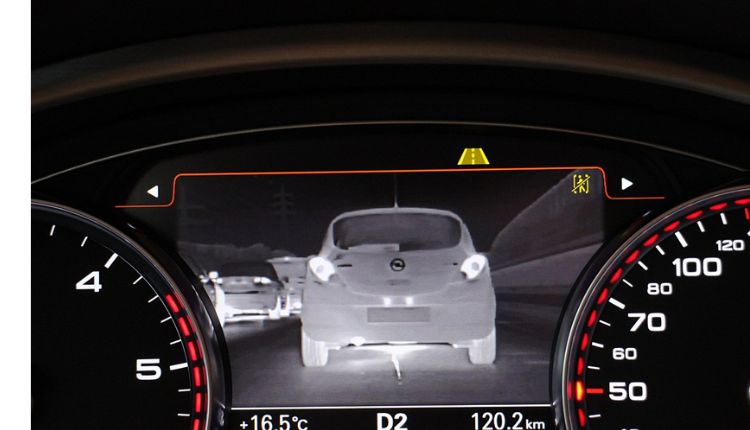When something bad happens, various emergency services come to the rescue. Police, ambulances, firefighters and rescuers – they are all ready to act at any time of the day. Even at night, these services are prepared to respond to a call and perform their job effectively. How do they do it? By using night vision devices. They provide good visibility in any environment, allowing police, rescuers, firefighters, and doctors to perform their duties effectively. Below are the devices available on all emergency vehicles, along with their application options.
What NVDs are used on emergency vehicles?
Night vision is a cutting-edge technology with numerous applications. In emergency vehicles, it plays a crucial role, enabling doctors, rescuers, firefighters, and police officers to perform their duties efficiently at any time of day or night. Different NVDs are used for other purposes. The most popular are NV systems. They are integrated into the vehicle’s control process and enable safe driving in low-light conditions. These NV systems consist of many individual devices. Working together, they warn the driver of potential dangers on the road, help control the lane, identify road signs, and more. This is especially important for emergency vehicles, which often travel at high speeds and operate on remote roads with limited lighting.
Thermal imaging systems are also used in emergency vehicles. They are designed to detect pedestrians, animals, cyclists and other cars. They do this even in complete darkness, so drivers have the opportunity to drive quickly without fear of accidentally hitting a person who has come out onto the road. In addition to the various systems that are integrated into the vehicle’s operation, emergency vehicles often contain portable NV and TI devices. They are designed to solve hundreds of different tasks and are used just as frequently as the equipment of other emergency service personnel. Night vision goggles, thermal imaging monoculars and binoculars, as well as night cameras that combine the capabilities of both technologies, are just a few examples of such devices.
Applications
Police, ambulance, rescue services and firefighters cannot do without night vision in their vehicles. It is actively used for various tasks and becomes the key to providing the fastest possible assistance to victims. Below are the most common cases in which multiple NVDs assist emergency services personnel in their duties.
Police
Most often, police officers use the capabilities of night vision and thermal imaging technologies in their cars. With their help, it is possible to increase the effectiveness of various events and make the lives of ordinary people safer. Patrolling in the dark is the most common use case for NVDs. During this time, such devices help police car drivers see the road normally, even in unlit areas of the city, and identify illegal activities or suspicious individuals. Pursuing suspects is another popular option for using NVDs. Thanks to the ability of such devices to improve visibility in the dark, police officers can safely drive at maximum speed. Monitoring compliance with law and order during mass events is another option for using night optics in police cars. The devices enable safe movement, crowd monitoring, and the quick identification of potentially dangerous actions.
Ambulance
Car accidents, accidental injuries, exacerbations of various diseases or a simple deterioration in health can happen to a person anywhere and at any time. Therefore, ambulance workers need to be able to reach the victim as quickly as possible, even if he is far from the city. In this case, thermal imagers and night vision devices become the main assistants. They allow ambulance drivers to accelerate to high speeds and drive safely even on unlit roads. Searching for victims is another option for using NVDs. Thanks to them, ambulance workers can move around in their cars and find people in need of help. This is especially important during large-scale natural disasters and other similar incidents. Good visibility in the dark, made possible by the presence of thermal imagers and night vision devices in ambulances, also helps speed up the process of transporting people to hospitals. This makes it possible to save a considerable number of priceless lives and a significant amount of time.
Firefighters and rescuers
The work of firefighters and rescuers is always a dangerous occupation. Employees of these services risk their lives every day to save someone else’s. Night vision increases the safety of these people. It is actively used on specialized vehicles used for extinguishing fires, clearing building rubble, and a variety of other purposes. NVDs are also becoming indispensable on firefighters’ and rescuers’ vehicles, which they use to get to the scene of an incident. Due to good visibility and situational awareness, specialists get to the right place as quickly as possible, bypassing various obstacles and dangers. Night vision on firefighters’ and rescuers’ vehicles plays a crucial role in the evacuation of victims. It makes it possible to remove people from the danger zone and prevent them from being exposed to additional danger.
The future role of NVDs on emergency vehicles
To assist people more quickly, new methods of work for emergency service employees are regularly developed, special training is conducted, and various equipment is improved. Emergency vehicles do not bypass this process. They are modernized, taking into account current needs, and have become even more unique cars. Various NVDs are also being improved concurrently. In the future, they will become even more versatile, reliable and durable devices that will enhance the quality of assistance in emergencies.
The main change in thermal imagers and devices in emergency vehicles will be the broader use of artificial intelligence capabilities. It will enable the recognition of people, animals, and other hazards on the road as quickly as possible. This will increase the safety of emergency service employees and allow them to reach the scene of an incident more quickly, even in complete darkness. Additionally, NV and TI systems with augmented reality capabilities should be integrated into the emergency vehicles of the future. Such equipment will enable the projection of various cues onto the windshield of a car (for example, indicating the presence of obstacles ahead, changes in the location of victims, etc.), assisting specialists in their complex work.
In the future, it may be possible to transmit images from various NVDs in emergency vehicles to the coordination center. This information will be received in real-time, allowing for accurate assessment of the current situation and coordination of actions among team members, including doctors, police officers, firefighters, and rescuers.
Today, emergency services cannot do without night vision devices on their vehicles. They help them cope with dozens of complex tasks in low-light conditions and save people’s lives. The efficiency and wide capabilities of such equipment make it an indispensable assistant in various situations. Even in extreme conditions, they will always provide good visibility, helping emergency service representatives perform their work efficiently.






